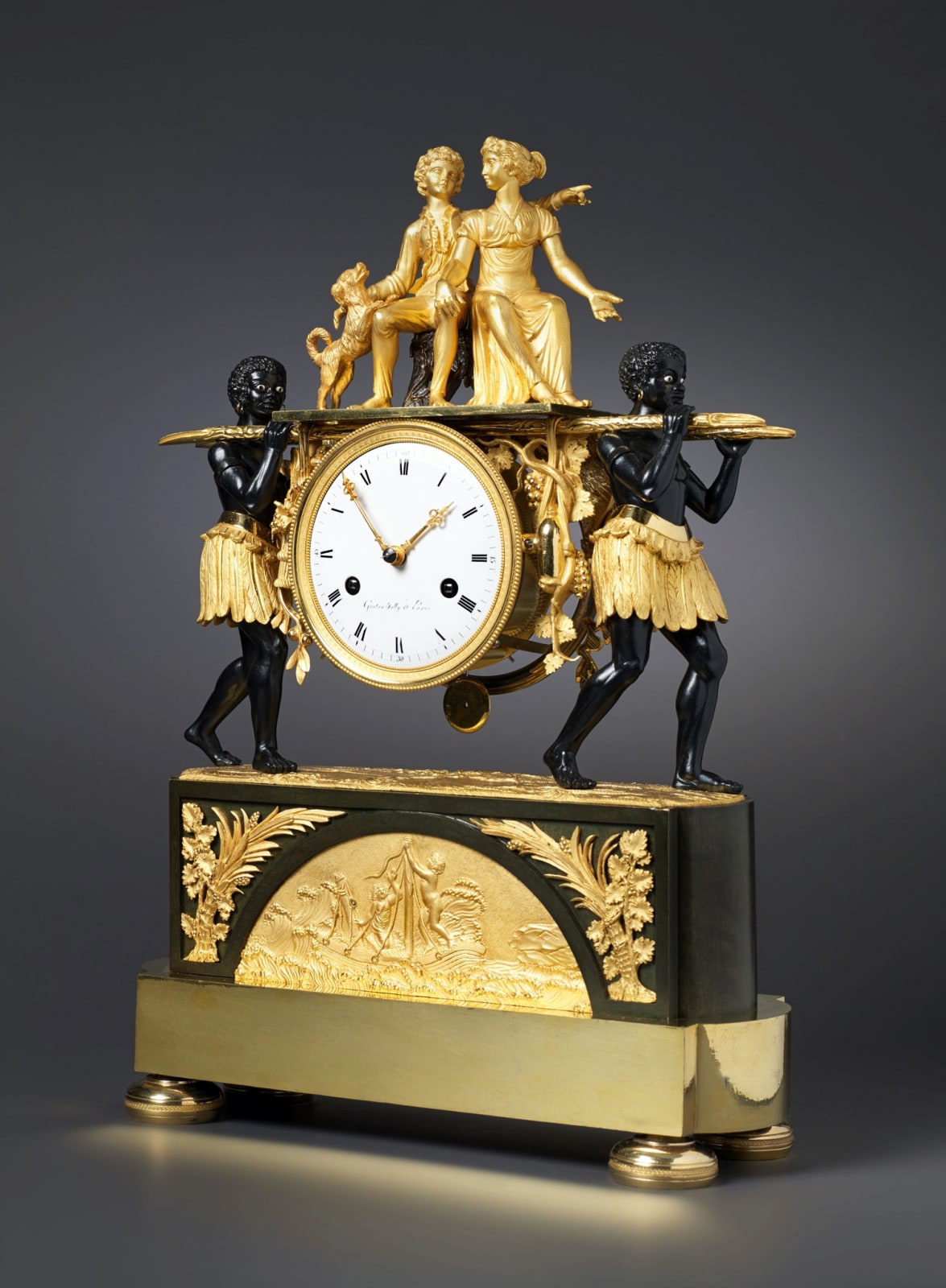Pierre-Francois-Gaston Jolly
Literature
Hans Ottomeyer and Peter Pröschel, “Vergoldete Bronzen”, 1986, p. 379, pl. 5.15.20, illustrating a similar clock but without the figures of Paul et Virginie. Pierre Kjellberg, “Encyclopédie de la Pendule Française du Moyen Age au XXe Siècle”, 1997, p. 358, pl. B, illustrating an identical clock case dated circa 1800 signed on the dial Corbet à Toulouse and pl. A illustrating a different figural clock case inspired by the story of Paul et Virginie. Elke Niehüser, “Die Französische Bronzeuhr”, 1997, p. 151, pls. 243-5, illustrating another almost identical clock case in the Musée François Duesberg at Mons and p. 152, pls. 246-7, illustrating a similar case by Pierre-Philippe Thomire of 1802 in the Musée François Duesberg at Mons, and p. 237, pl. 805, illustrating an image of the same clock case model.
This magnificent clock portraying Paul et Virginie closely relates to a larger model measuring 70 cm high made by the esteemed bronzier, Pierre-Philippe Thomire (1751-1843) which was commissioned in 1802 by Napoleon Bonaparte. The latter intended to give it to Jacques Henri Bernardin de Saint-Pierre (1737-1814) since he was the so enchanted by his tragic love story of Paul et Virginie. Thomire’s clock is now in the Musée François Duesberg at Mons, as is another version of the present clock.
A beautiful Empire patinated and gilt bronze mantel clock of eight day duration by Pierre-Francois-Gaston Jolly, known as Gaston Jolly signed on the white enamel dial Gaston Jolly à Paris, the dial with Roman and Arabic numerals and a pair of gilt brass hands for the hours and minutes. The movement with silk thread suspension, striking on the hour and half hour on a single bell with outside count wheel. The magnificent case surmounted by the figures Paul et Virginie with a leaping dog to symbolize fidelity and carried on a palanquin held aloft by two African natives with white enamel eyes and plumed skirts, the clock drum supported on a rectangular pedestal with frieze borders of palm fronds and semi-circular cast mount depicting Paul and Virginie amid the shipwreck
Paris, date circa 1800-05
Height 46 cm, width 32 cm, depth 12 cm.
Published in 1788, Bernardin de Saint-Pierre’s novel Paul et Virginie attained an immense vogue and influenced the French romanticists. It was also to inspire an opera as well as a number of clock cases. These cases, known collectively as pendules au bon sauvage reflected the European fascination with the exotic and, in their eyes, the unadulterated and untamed natural world. The same theme was aired in Saint-Pierre’s novel which was essentially a critique of contemporary aristocratic French culture and its destructive nature, in contrast with the uncorrupted and egalitarian world of Paul and Virginie. The story was set on the island of Mauritius between 1735-1762 and tells of the growing love between Paul and Virginie. Their mothers had both left France in disgrace and hoped to find a new life in colonial Mauritius. There their children were raised as siblings amongst idyllic tropical surroundings, but in young adulthood they fell in love, upon which they were separated by their mothers. Virginie was sent to a wealthy aunt in France but found that she could not adapt to European life and so returned to her beloved. The concluding part of the story is illustrated on the pedestal frieze: as Virginie’s ship neared the island it was wrecked in a terrible storm. Paul swum to Virginie’s rescue but was too late and thus returned with her body to the shore where he died of exhaustion and sorrow.
The movement for this remarkable clock was made by Pierre-Francois-Gaston Jolly, better known as Gaston Jolly (d. 1824) who was one of the leading Parisian clockmakers during the late eighteenth and early nineteenth centuries. He was received into the Parisian guild of maître horlogers on 6th May 1784 and during his illustrious career enjoyed the patronage of Bernard-Charles-Louis-Victor marquis de Lostanges-Beduer as well as Charles-Philibert-Marie-Gaston de Lévis, comte de Mirepoix’s wife. In keeping with the current tastes his early clocks were often housed in the finest Louis XVI style cases of which some were supplied by the master bronziers Robert and Jean-Baptiste Osmond. Gaston Jolly also made a number of watches, one of which has an elaborate enamel case painted with a scene from Jacques Rousseau’s opera Colin and Colette and is housed in the Petit Palais in Paris. Like the latter, the present skeleton clock is of the highest quality. A number of similar but not identical examples are known including an example by Noël Bourret which has an equally fine enamel dial and frame by the supreme enamellist Joseph Coteau (1740-1812). Given the similarity between the two clocks, it is likely that Coteau was also responsible for the enamel decoration on the present clock.
When he became a maître in 1784, Gaston Jolly was established at rue des Arcis and then at rue Michel le Compte (later renamed rue Michel le Pelletier) before he moved to boulevard Poisonnière, where he died in late 1824. He married Marie-Catherine Baudin who died in 1784 shortly after their wedding and by whom he had one son, also named Pierre-Francois-Gaston Jolly. The latter followed his father’s profession as a clockmaker and during the early years of the nineteenth century was established at rue du Pavée Saint-Sauveur, where his own wife Marie-Madeleine-Rose died in late 1812 or January 1813.
